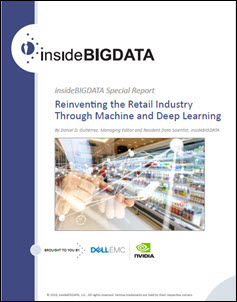 The use of data for competitive advantage is not new to the retail industry—having taken a pioneering role for cultivating customer analytics both online and in-store. As a result, modern retailers leverage a growing collection of retail data to understand everything from customer buying behavior, product trends and product pricing optimization, to what to stock, how much to buy, what products to suggest to repeat customers, precise ad targeting, and so much more.
The use of data for competitive advantage is not new to the retail industry—having taken a pioneering role for cultivating customer analytics both online and in-store. As a result, modern retailers leverage a growing collection of retail data to understand everything from customer buying behavior, product trends and product pricing optimization, to what to stock, how much to buy, what products to suggest to repeat customers, precise ad targeting, and so much more.
Today, deep learning techniques are poised to disrupt the retail industry. As artificial neural networks become more and more efficient, and as graphics processing units (GPUs) get more and more powerful, so does their influence on retail. Imagine a world in which deep learning-based systems know precisely what a customer wants. In such a scenario, retailers would cater to their customers more quickly and more efficiently.
Imagine further a world in which deep learning techniques predict future preferences and needs. Retailers would no longer buy excessive stock in items in order to make up for an eventual rise in the demand, because they would know ahead of time the demand for certain products. It would be a situation of mutual gain for both retailers and customers. The possibilities are endless.
[clickToTweet tweet=”U.S. retailers adopting data analytics have seen up to a 19% increase in operating margin over the last 5 years. ” quote=”A recent study by McKinsey found that U.S. retailer supply chain operations who have adopted data analytics have seen up to a 19% increase in operating margin over the last five years. Data is clearly effective for retailers, but it’s all about putting it to work in the right areas and adding in predictive capabilities.”]
In order to sort out important nomenclature, a recent insideHPC Special Report—Riding the Wave of Machine Learning & Deep Learning—offers a closer look at the differentiation between AI, machine learning and deep learning, and the impact they’re having on the global business landscape.
The insideBIGDATA Special Report: Reinventing the Retail Industry through Machine and Deep Learning white paper explores how AI, machine learning and deep learning are transforming the retail industry in many positive directions including:
- Inventory and supply chain management
- Analysis of customer buying patterns
- Analyzing traffic patterns
- Providing assortment planning
- Performing retail analytics at scale
- Fighting cyberfraud
Intelligent Retail Inventory Management
One prominent area of the retail industry where machine learning is serving to embody the concept of smart automation is supply chain and inventory management. Companies are now able to leverage an abundance of data in new ways, e.g. preventing costly facility malfunctions, meeting customer expectations in terms of product demand and service, and advancing ROI over the long term.
Here are a few compelling use case examples:
- Using autonomous retail robots on the front-end by helping customers find products, and also on the back-end for inventory audits;
- Utilizing Internet-of-things (IoT) to provide connected monitors of the supply chain and equipment that can send alerts about potential problems before they become an issue that would disrupt the movement of merchandise;
- Employing predictive analytics technology that can be used to help determine supply chain availability and demand based on weather.
In the retail world, supply chain efficiency is essential for competitive success. Inventory management, picking, packing and shipping are all time and resource-intensive processes that tend to have a dramatic impact on a company’s bottom line.
Here is a short list of ways that predictive analytics provides benefit to retailers in terms of intelligent inventory management:
- Filling customer needs more quickly through running detailed simulations that allow the effects of lateness or missed deadlines to be assessed before they become an issue;
- Reducing downtime due to faults and breakage. In supply chain logistics, predictive maintenance is starting to be used in data-driven “picking and packing” operations, as well as across transport channels;
- Cutting “shrinkage” and maximizing stock. In retail, a certain number of units will be lost due to damage, inventory mismanagement, errors of stocktaking, as well as fraud and theft. Using predictive analytics, there are a multitude of opportunities to reduce—and perhaps in some areas eliminate—this “shrinkage.”
- Classification techniques can be used to make predictions such as the likelihood that an order will be late and by how many days.
AI is changing inventory management and supply chains. Specifically, AI adoption, by way of the use of optimization algorithms, is revolutionizing inventory agility by reducing stock depletions and maximizing stock levels. The use of AI in supply chains is helping companies take large strides in innovation by reducing the time to market and to evolve by establishing an agile supply chain capable of foreseeing and dealing with uncertainties.
Article Series
In a series of articles over the next few weeks we will explore these topics:
- Introduction, Intelligent retail inventory management
- Analyzing buying patterns, analyzing traffic patterns, assortment planning
- Retail analytics at scale, Deep learning for maintaining privacy and combating fraud
- Dell EMC machine learning and deep learning ready bundles, summary
If you prefer, the complete insideBIGDATA Special Report: Reinventing the Retail Industry through Machine and Deep Learning is available for download in PDF from the insideBIGDATA White Paper Library, courtesy of Dell EMC and NVIDIA.




Speak Your Mind